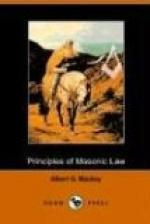The ceremony of dedication, like that of consecration, finds its archetype in the remotest antiquity. The Hebrews made no use of any new thing until they had first solemnly dedicated it. This ceremony was performed in relation even to private houses, as we may learn from the book of Deuteronomy.[30] The 30th Psalm is a song said to have been made by David on the dedication of the altar which he erected on the threshing-floor of Ornan the Jebusite, after the grievous plague which had nearly devastated the kingdom. Solomon, it will be recollected, dedicated the temple with solemn ceremonies, prayers, and thank-offerings. The ceremony of dedication is, indeed, alluded to in various portions of the Scriptures.
Selden[31] says that among the Jews sacred things were both dedicated and consecrated; but that profane things, such as private houses, etc., were simply dedicated, without consecration. The same writer informs us that the Pagans borrowed the custom of consecrating and dedicating their sacred edifices, altars, and images, from the Hebrews.
The Lodge having been thus consecrated to the solemn objects of Freemasonry, and dedicated to the patrons of the institution, it is at length prepared to be constituted. The ceremony of constitution is then performed by the Grand Master, who, rising from his seat, pronounces the following formulary of constitution:
“In the name of the most Worshipful Grand Lodge, I now constitute and form you, my beloved Brethren, into a regular lodge of Free and Accepted Masons. From this time forth, I empower you to meet as a regular lodge, constituted in conformity to the rites of our Order, and the charges of our ancient and honorable fraternity;—and may the Supreme Architect of the Universe prosper, direct, and counsel you, in all your doings.”
This ceremony places the lodge among the registered lodges of the jurisdiction in which it is situated, and gives it a rank and standing and permanent existence that it did not have before. In one word, it has, by the consecration, dedication, and constitution, become what we technically term “a just and legally constituted lodge,” and, as such, is entitled to certain rights and privileges, of which we shall hereafter speak. Still, however, although the lodge has been thus fully and completely organized, its officers have as yet no legal existence. To give them this, it is necessary that they be inducted into their respective offices, and each officer solemnly




